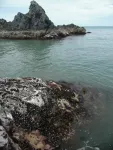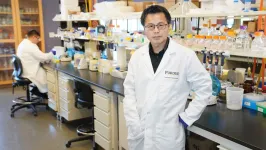(Press-News.org) By combining the scientific powerhouses of genetics and geology, University of Otago researchers have identified a new area of coastal uplift, which had been hiding in plain sight.
The previously unknown region of earthquake uplift, in Rarangi, Marlborough, was discovered using a combination of new data from laser mapping and kelp genetics.
Co-author Professor Jon Waters, of the Department of Zoology, says the study gives new insights into the changes in Aotearoa’s landscapes and the recent history of earthquake impacts.
“In a geologically well studied country like New Zealand, there is still a lot to learn about our history of earthquakes and changing landforms,” he says.
The paper, just published in Journal of the Royal Society Interface, utilised LiDAR mapping (remote sensing technology used to model ground elevation) and genetic analysis of bull kelp from the uplifted section of coast.
The team identified a previously unrecognised area of uplifted rocky coastline – a bench about 1m above sea level – and a genetic anomaly in kelp below that bench. The kelp’s genetics indicate the species went extinct in the area following an earthquake, before being recolonised by kelp which drifted from 300km south.
The group believe the earthquake responsible occurred about 2000 to 3000 years ago, showing the potential for kelp to record geological disturbance events.
“The area is close to a well-known active fault and several big, past earthquakes have been well quantified by other researchers, but this coastal uplift zone was not previously known – the evidence for it is extremely clear now we’ve had a chance to look more closely.
“Rarangi is also a very popular summer swimming spot, rather than some obscure or remote location, and the evidence of coastal uplift was hiding in plain sight,” Professor Waters says.
The research is the latest output from the group’s Marsden-funded project assessing earthquake impacts on coastal species.
“Our work uses a combination of genetics and geology, and it’s quite exciting that these combined approaches have allowed us to pinpoint a previously unknown site of coastal uplift in New Zealand.
“This work serves to highlight again just how dynamic our country is – and how earthquake uplift leaves long lasting signatures in our coastal species.”
By combining the scientific powerhouses of genetics and geology, University of Otago researchers have identified a new area of coastal uplift, which had been hiding in plain sight.
The previously unknown region of earthquake uplift, in Rarangi, Marlborough, was discovered using a combination of new data from laser mapping and kelp genetics.
Co-author Professor Jon Waters, of the Department of Zoology, says the study gives new insights into the changes in Aotearoa’s landscapes and the recent history of earthquake impacts.
“In a geologically well studied country like New Zealand, there is still a lot to learn about our history of earthquakes and changing landforms,” he says.
The paper, just published in Journal of the Royal Society Interface, utilised LiDAR mapping (remote sensing technology used to model ground elevation) and genetic analysis of bull kelp from the uplifted section of coast.
The team identified a previously unrecognised area of uplifted rocky coastline – a bench about 1m above sea level – and a genetic anomaly in kelp below that bench. The kelp’s genetics indicate the species went extinct in the area following an earthquake, before being recolonised by kelp which drifted from 300km south.
The group believe the earthquake responsible occurred about 2000 to 3000 years ago, showing the potential for kelp to record geological disturbance events.
“The area is close to a well-known active fault and several big, past earthquakes have been well quantified by other researchers, but this coastal uplift zone was not previously known – the evidence for it is extremely clear now we’ve had a chance to look more closely.
“Rarangi is also a very popular summer swimming spot, rather than some obscure or remote location, and the evidence of coastal uplift was hiding in plain sight,” Professor Waters says.
The research is the latest output from the group’s Marsden-funded project assessing earthquake impacts on coastal species.
“Our work uses a combination of genetics and geology, and it’s quite exciting that these combined approaches have allowed us to pinpoint a previously unknown site of coastal uplift in New Zealand.
“This work serves to highlight again just how dynamic our country is – and how earthquake uplift leaves long lasting signatures in our coastal species.”
END
Otago researchers reveal impact of ancient earthquake
2023-05-17
ELSE PRESS RELEASES FROM THIS DATE:
ESHRE publishes recommendations to tackle environmental threats to fertility and reproductive health
2023-05-17
Political and legislative action is urgently needed to respond to threats posed by the link between environmental factors and widespread infertility, says the European Society of Human Reproduction and Embryology (ESHRE) today (Wednesday).
This is one of the (8) recommendations outlined in a list of statements published by ESHRE for the first time. The aim is to draw attention to the growing threat from climate change, pollutants, hormone-disrupting chemicals, toxic substances, and other related risks.
The ...
What’s a park worth to the economy?
2023-05-17
A new framework developed by University of Waterloo researchers demonstrates the significant economic health savings and benefits from urban park investments.
In the first case study of its kind in Canada, researchers looked at Peterborough’s new Quaker Foods City Square park, which cost taxpayers $6.4 million, and have estimated the economic value of physical and mental health benefits that could come from it at more than $4 million per year. The framework considers the health savings associated with improved mental health and better air quality, the ...
New liquid biopsy method offers potential fornoninvasive Parkinson’s disease testing
2023-05-17
New liquid biopsy method offers potential for noninvasive Parkinson’s disease testing
EVtrap technology identifies proteins from brain cells in urine samples
WEST LAFAYETTE, Ind. – A team led by researchers at Purdue University and Purdue spinoff company Tymora Analytical Operations has developed a technique that may reveal signs of Parkinson’s disease in urine samples.
The technique gives researchers a chance to see if LRRK2 (leucine-rich repeat kinase 2) proteins, which are linked to Parkinson’s disease, and their downstream pathways are altered in samples from Parkinson’s patients. The method could eventually lead ...
GW to co-lead a new $20 million NSF AI institute
2023-05-16
WASHINGTON (May 16, 2023) - The George Washington University is co-leading a multi-institutional effort supported by the National Science Foundation (NSF) that will develop new artificial intelligence (AI) technologies designed to promote trust and mitigate risks, while simultaneously empowering and educating the public.
The NSF Institute for Trustworthy AI in Law & Society (TRAILS) announced on May 4, 2023, unites specialists in AI and machine learning with systems engineers, social scientists, legal ...
Discrimination, crime and suicidal thoughts associated with greater odds of firearm ownership among Black adults
2023-05-16
Black adults – particularly Black women – with higher levels of education and experiences of discrimination and crime are more likely to own a firearm, according to a study by the New Jersey Gun Violence Research Center at Rutgers.
In a new study appearing in the Journal of Clinical Psychology, researchers found that Black adults who endorsed firearm ownership were more likely to grow up in homes with firearms, had previously shot a firearm and planned to acquire a firearm in the coming year.
“The higher rates of firearm ownership among highly educated Black women were somewhat surprising to us,” said Michael Anestis, executive director ...
Some young cancer survivors face higher risk of premature heart failure
2023-05-16
Mean age at diagnosis of heart failure was 32 years old
First study to estimate risk of heart failure among young adult cancer survivors treated with this category of chemotherapy
Study raises awareness for patients, clinicians to monitor for heart failure symptoms, consider strategies for prevention
CHICAGO --- Imagine surviving cancer only to learn the drug that saved your life has introduced a completely different health risk: heart failure.
A new Northwestern Medicine study has found young adult cancer survivors (between 18 and 39 years old at diagnosis) were at higher risk (2.6 times) of heart failure when treated with anthracyclines, a specific category ...
New research sheds light on how shift work may influence fertility
2023-05-16
Only four weeks of shift work-like patterns in female mice are enough to disrupt their biological clock and reduce fertility, according to research presented at the 25th European Congress of Endocrinology. The findings help scientists better understand how circadian disturbances impact female fertility, which could eventually lead to future prevention strategies for women working in non-standard work schedules.
The circadian rhythm is generated by the body’s internal clocks which are synchronised to a 24-hour period, mostly by changes in light across days. These clocks regulate various biological functions and processes, including the sleep-wake cycle, ...
Drs. Dawn Hershman and Primo Lara elected group co-chairs-elect of SWOG Cancer Research Network
2023-05-16
The board of governors of the SWOG Cancer Research Network has elected Primo N. Lara, Jr., MD, and Dawn L. Hershman, MD, MS, as group co-chairs-elect. The two will serve in that capacity until the term of the current group chair, Charles D. Blanke, MD, ends in spring 2025. They will then begin a six-year term as SWOG’s first group co-chairs.
In a joint statement, Hershman and Lara said, “We both understand that the success of SWOG has been fundamentally anchored in collaborative interdisciplinary team science. We are convinced ...
At the foot of the geologically diverse front range
2023-05-16
Boulder, Colo., USA: The Geological Society of America (GSA) is pleased to announce the upcoming 2023 GSA Rocky Mountain Section Meeting to be held from 23–25 May in Fort Collins, Colorado, USA. This highly anticipated event will provide a dynamic platform for scientists, researchers, industry professionals, and students to exchange ideas, present research findings, and foster collaborations. The meeting will feature a wide range of engaging sessions, a plenary lecture on climate intervention, scientific field trips, informative short courses, and impactful mentoring programs ...
Chan Zuckerberg Initiative funds COMBINEDBrain to fast track research for rare neurological disorders
2023-05-16
COMBINEDBrain’s Founder and Director, Dr. Terry Jo Bichell, understands the power of collaboration. In her years as a neuroscientist, advocate, and rare patient parent, she has witnessed the field of neurodevelopment transform from a broad focus on autism or intellectual disability, to an era based on rare genetic disorders. When new disorders are identified, Patient Advocacy Organizations spring up, led by passionate parents with the drive and determination to cure their children. Some of these organizations represent as many as 10,000 patients, some as few as 10. No matter their size, each organization must follow a similar path to ...




